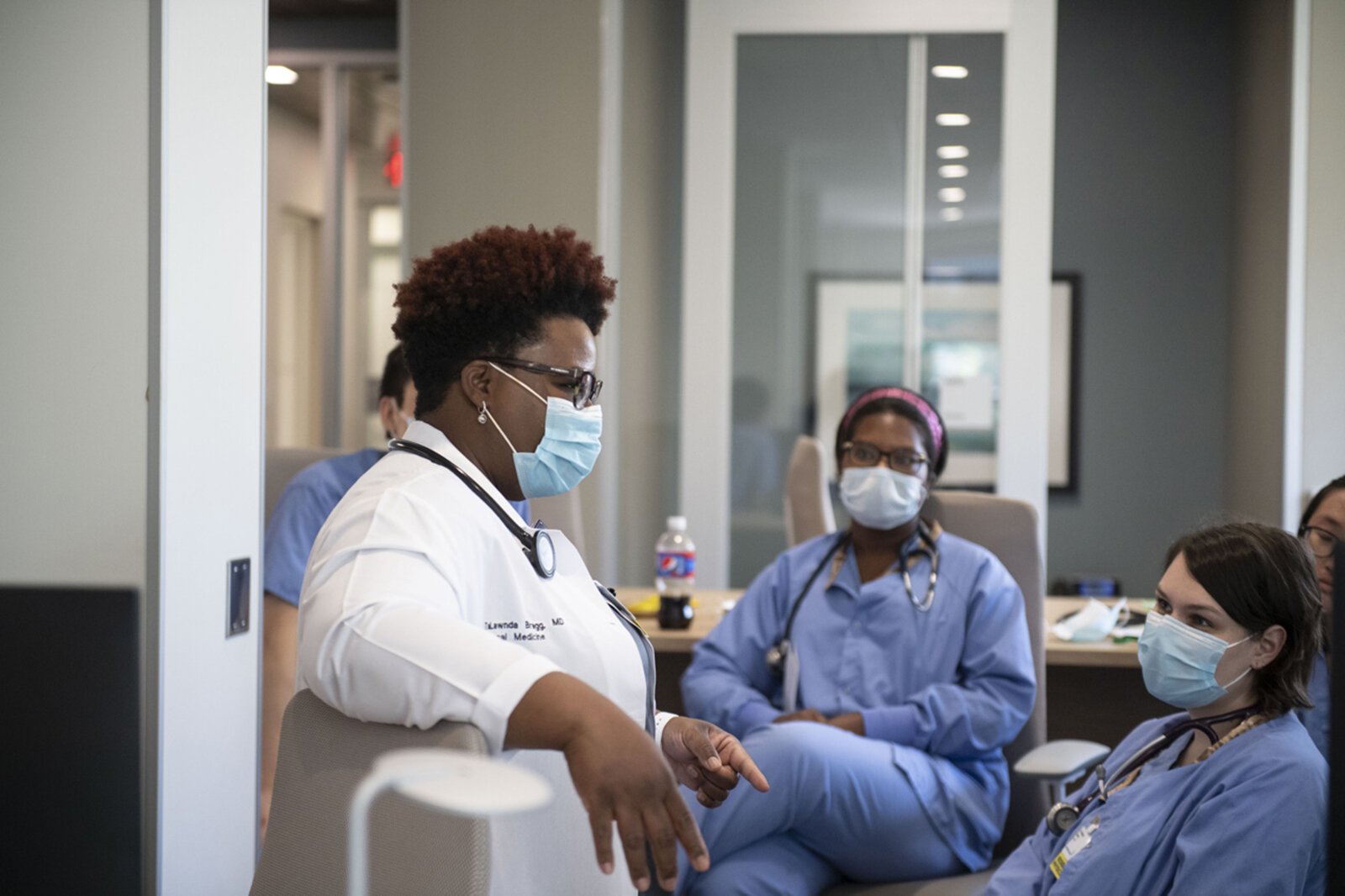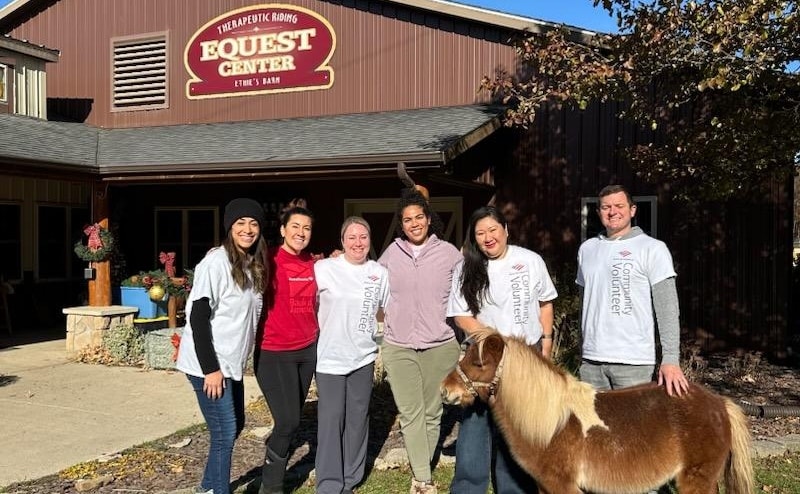Job growth and educational opportunities in health care expand and adapt post-COVID
In-person learning opportunities that were put on hold during the pandemic have been adapted to a new hybrid environment, and the pipeline for talented doctors and nurses is once again being expanded in West Michigan.

As we near a second year of the COVID pandemic, the demand for health care professionals is greater than ever. Now facing new variants and a surge in infections, hospitals and clinics are stretched to their limits. In larger cities, some medical facilities are understaffed to the point of turning patients away, exposing disparities in access to health care and service opportunities.
It’s no longer enough to simply post job openings or earmark more funding for medical schools when the impact of those initiatives fall short of reaching the most vulnerable populations.
Addressing disparities in care and opportunity
“There’s a lot of evidence that shows that Black and brown individuals have low quality of care, and it is not always intentional,” says Valissa Armstead, Spectrum Health’s director of Diversity, Equity and Inclusion. “A lot of it is deeply ingrained in biases just based on how our policies and practices and even the teachings in the medical field have been done over the years.”
Disparities in health care extend beyond race lines into cultural and community issues, Armstead says. Historical wounds, even though not experienced first-hand, also impact an individual’s perception of certain initiatives as helpful or harmful.
“The Tuskegee experiment, Henrietta Lacks, things of that nature, where you utilize Black and brown individuals for experiments when the ultimate goal was to actually help treat individuals and help them survive through things like pandemic or diseases,” Armstead says.
With these barriers to access in focus, one outcome of the last 20 months has been a greater emphasis on diversity and inclusion in the healthcare industry.
Spectrum Health’s Healthier Communities department helped set up community-wide vaccination facilities in early 2020, but it was Armstead’s DEI team who was “pulled into the frontlines to have a voice to bring the voice of the community to the table from the start.”
The widespread collaboration included interfaith institutions, long-term care facilities, volunteers from the community and others working to change how people are taken in and cared for.
“That included learning how we could help in the process of designing strategies and interventions that will best support our community,” Armstead says. “That’s something that a lot of health care institutions had not done in the past.”
Armstead says Spectrum Health has been applying an equity lens to these conversations before news of a global pandemic even hit the U.S. She cites the Social Vulnerable Index as one tool that helped emphasize communities that were most vulnerable, but still faced a lot of barriers, such as transportation. Community clinics were brought into those zip codes that were hardest hit.
“When the strategies were first put in place, there was a heavy emphasis on people going into affected communities and utilizing technology to schedule appointments. Then we recognized that technology was a barrier” Armstead says. “We went old school, removing whatever barriers that we could find. That happened only because we were having conversations with community members who faced those barriers. What better subject matter expert can you get? To hear from those individuals who have the barriers and then be able to move those?”
Bringing in diverse talent
Corporate positions focused on diversity have been gaining popularity for years, but the instantiation of a separate diversity and inclusion department within a health care system is still a new concept, Armstead says.
“Most people see diversity and inclusion as only focusing internally and helping to do things such as increased representation. Representation does matter in terms of employment,” Armstead says. “Being able to retain, promote and improve individuals is important. More importantly, making sure that the voices at the table really matter, and that diverse perspectives and lived experiences are at the table.”
Spectrum Health’s DEI team is now pushing for greater intentionality in hiring a diverse staff, “so that people can continue to feel welcome but more importantly, feel safe, ask questions, and also be provided with care right in their own backyard.”
On the hiring side, one competency that has proven critical throughout the pandemic is adaptability, says Eric VanDuren, senior director of talent acquisition at Spectrum Health.
“Change is pretty much our new normal,” VanDuren says.
With the “great resignation” still in swing, the American workforce has shrunk and job seeking individuals have many more options right now than in years past. Employers looking for ways to attract new talent must differentiate themselves from the competition, and one way to do that is through prioritizing diversity, equity and inclusion.
“It is not just a phrase but something that’s woven within your fabric, actually what you live,” VanDuren says. “Those individuals who work for the organization will also be biggest advocates in drawing others in who are also able to adapt. I think they are well set up to join a health care organization.”
STEM careers in the making
Cassandra Hankins is a community program supervisor for the Healthier Communities program, working out of Grand Rapids Public Schools’ Innovation Central High School Academy of Health Sciences and Technology. She helps Spectrum Health team members serve as mentors, speaking to students about opportunities in the health field and how to create healthier communities.
“Doctors and nurses are always on the shortage list, nationally,” Hankins says. “We’re trying to increase the number of GRPS students who choose a health care career. And we’ve aligned the curriculum to prepare the students for health, science and technology. The ultimate goal is to employ students at [Spectrum Health].”
During much of the last 20 months, classroom mentoring, job shadowing and in-person observations were put on hold. College tours, career fairs and dinner meetings were canceled. The progress Hankins had been making nearly came to a standstill.
Going virtual from March 2020 through January 2021, Hankins saw little engagement with online presentations. Switching to a hybrid model after January, with students allowed to return to the classroom or attend virtually.
Now that in-person classes have resumed, Hankins is bringing speakers back into school, once a month, to give the students a snapshot of their career.
“Nurses come in and share what they customarily do, but also the nuances that they find in that role,” Hankins says. “They share what education was needed to do this, where they went to school, which schools offer the right programs, how much schooling costs, and the typical compensation range.”
Job shadowing programs are also back in session. Hankins’ students are currently working with a physical therapy professional. Not every facet of pre-pandemic normalcy has returned to Innovation Central, though. Hankins’ favorite field trips, in particular, are yet on hold.
Hankins recalls when she would bring students to the hospital to participate in a disaster drill.
“They would give all the students different cards with a scenario, or a victim profile that they’re going to act out. One of my personal favorites involved students working to take in patients that might have gotten some chemicals on them, like gasoline.
Before the patients can come into the hospital, they must be hosed down in a special tent set up outside.
“The students had way too much fun with it,” Hankins says.
Even in the spring, when temperatures dropped into the 30s, students would shower off lacerations made of costume makeup, while snapping photos to send to their parents.
Students as young as ninth grade are involved in programs focused on medical careers through Innovation Central. Hankins says there are currently 112 out of a class of 200 involved in the Life EMS, pharmacy tech, mental health certification or other programs.
Information Services and Technology opportunities
COVID disruptions and the Great Resignation have had a smaller impact on Spectrum Health’s Information Services Career Pathways program. Growth and opportunities are on the upswing, according to Sharon Vriend-Robinette, a senior project specialist at Spectrum Health.
Vriend-Robinette is leading an effort to connect students at local schools like GRPS, Grand Rapids Community College and the West Michigan Center for Arts and Technology to careers within the Spectrum Health IS team. Vriend-Robinette says internship opportunities in the IS department were put on hold during the initial pandemic until Spectrum Health opened up a limited virtual college internship program in 2020, later expanded to an academic year internship program to accommodate more graduating students.
“We were able to accommodate students virtually except for those who would have to be in the clinical spaces with technology,” Vriend-Robinette says. “
Students at the University of Michigan, Michigan State University, Ferris State University, Grand Valley State University, Grand Rapids Community College. Southwest Michigan College, and other schools currently serve as Spectrum Health interns. Vriend-Robinette says opportunities will be expanding into local schools, too.
“We’re working on a partnership with UPrep, WMCAT and GRCC that will provide students access to technology education, career exploration and leadership development,” Vriend-Robinette says. “We’ve also started an apprenticeship program this year for individuals that do not have formal experience or education in areas of technology for which we have high demand.”
The apprenticeship program is based on the Step IT Up America program, which is designed to train and employ women, minorities and veterans in STEM fields. From West Michigan, seven community members who were looking to leverage technology in an effort to make a career change have completed 95 intensive teaching days with instructors from Step It UP and WMCAT and are now learning on the job at Spectrum Health, Vriend-Robinette says. If all goes well, they’ll join the Spectrum Health staff as full time employees by October 2022.
Health care market job growth in 2022
When it comes to finding a job in health care, “the opportunities are there,” VanDuren says. It’s simply a matter of engaging with employers.
“Whether that’s talking with local educational institutions, finding health care professionals on LinkedIn, or going to a local health care provider and looking for volunteer or career opportunities,’ VanDuren says. “Just get out there and engage in and try to learn.”
VanDuren says incoming staff at Spectrum Health not only have opportunities for growth, but opportunities to learn from others at every turn
“Once you get hired in, we’re here to help and we’re here to support you. You might not know what that next step in your career is or what your ultimate goal may be. We’re here to walk alongside you through training development opportunities and guidance, whatever that may be.”
This series is underwritten by Spectrum Health.
Matthew Russell is a writer and maker living in West Michigan. Matthew has over 20 years of experience as a journalist for various newspapers and magazines in the Midwest, has been published in two books about Grand Rapids history, and is currently improving his skills as an amateur apiarist while building a sustainable microfarm.









